
Michelfeld Abbey (German : Kloster Michelfeld) was a Benedictine monastery in Auerbach in der Oberpfalz in Bavaria, Germany.

Michelfeld Abbey (German : Kloster Michelfeld) was a Benedictine monastery in Auerbach in der Oberpfalz in Bavaria, Germany.
The monastery, dedicated to Saint Michael and Saint John the Evangelist, was founded in 1119 by Bishop Otto I of Bamberg. It was dissolved in the Reformation, in 1556. Re-opened temporarily in 1661 and permanently in 1684, it was put under the administration of the Electors of Bavaria on 13 March 1802 and finally dissolved in 1803 in the secularisation of Bavaria.
The abbey church, refurbished throughout in the Baroque style in the early 18th century by the Asam brothers, became the parish church. Other former monastic buildings now accommodate a care home of the Regens-Wagner-Stiftungen run by the Franciscan Sisters of Dillingen.
49°42′14″N11°35′14″E / 49.70389°N 11.58722°E

Ettal Abbey is a Benedictine monastery in the village of Ettal close to Oberammergau and Garmisch-Partenkirchen in Bavaria, Germany. With a community of more than 50 monks, with another five at Wechselburg, the Abbey is one of the largest Benedictine houses and is a major attraction for visitors.
Echenbrunn Abbey was a Benedictine monastery located at Echenbrunn, now part of Gundelfingen an der Donau in Bavaria, Germany.

Ensdorf Abbey was a Benedictine monastery located at Ensdorf in Bavaria, Germany. Dedicated to Saint James, the monastery was founded in 1121 by Pfalzgraf Otto of Wittelsbach. It was dissolved in 1556 but restored in 1669, only to be dissolved again in 1802 in the secularisation of the period.

Frauenzell Abbey was a Benedictine monastery situated in Frauenzell, which is part of Brennberg in Bavaria, Germany.
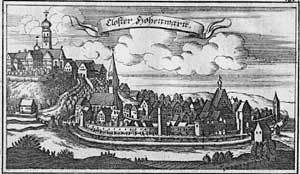
Hohenwart Abbey was a Benedictine nunnery located at Hohenwart in Bavaria, Germany.
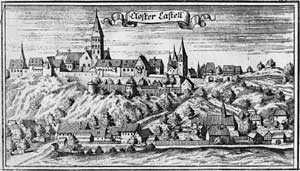
Kastl Abbey is a former Benedictine monastery in Kastl in the Upper Palatinate, Bavaria.

Vornbach Abbey was a Benedictine monastery in Neuhaus am Inn in Bavaria, Germany.

Altomünster Abbey was a monastery in the small Bavarian market town of Altomünster.
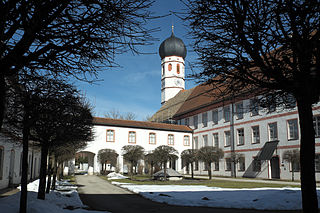
Beuerberg Abbey, formerly a monastery of the Augustinian Canons, is now the Monastery of the Visitation, Beuerberg, a community of the Visitandines in Eurasburg in Bavaria, Germany.

Theres Abbey was a Benedictine monastery in the village of Theres in the district of Hassberge, in Franconia in the north of Bavaria, Germany.

Prüfening Abbey was a Benedictine monastery on the outskirts of Regensburg in Bavaria, Germany. Since the beginning of the 19th century it has also been known as Prüfening Castle. Notably, its extant dedicatory inscription, commemorating the founding of the abbey in 1119, was created by printing and is a unique document of medieval typography.
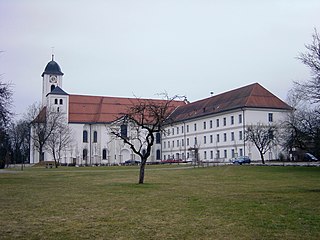
Rott Abbey was a Benedictine monastery in Rott am Inn in Bavaria, Germany.

Weissenohe Abbey was a Benedictine monastery in Weissenohe in the district of Forchheim in Bavaria, Germany.

Weltenburg Abbey is a Benedictine monastery in Weltenburg near Kelheim on the Danube in Bavaria, Germany.
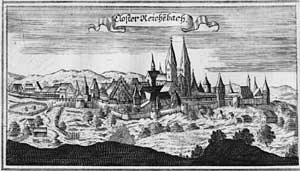
Reichenbach Abbey is a monastery of the Brothers Hospitallers, formerly a Benedictine monastery, in Reichenbach in Bavaria, Germany.

Wettenhausen Abbey was an Imperial Abbey of Augustinian Canons until its secularization in 1802–1803. Being one of the 40-odd self-ruling Imperial Abbeys of the Holy Roman Empire, Wettenhaussen Abbey was a virtually independent state. Its abbot had seat and voice in the Imperial Diet, where he sat on the Bench of the Prelates of Swabia. At the time of secularization, the Abbey's territory covered 56 square kilometers and it had about 5,400 subjects.
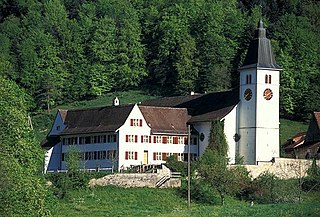
Beinwil Abbey was a Benedictine monastery in Beinwil in the Canton of Solothurn in Switzerland.

Polling Abbey is a former monastery in Polling bei Weilheim, district of Weilheim-Schongau, in Upper Bavaria, Germany.
Ursberg Abbey is a former Premonstratensian monastery, now a convent of the Franciscan St. Joseph's Congregation, situated in the small village of Ursberg in the district of Günzburg, Bavaria.

Prüll Charterhouse, previously Prüll Abbey, is a former Carthusian monastery, or charterhouse, in Regensburg in Bavaria, Germany.